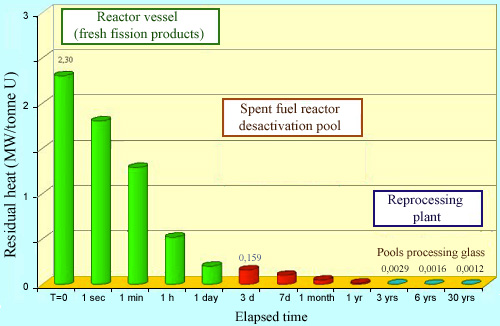Safety issues different to those faced by reactors

Sensitive facilities
Unlike in a reactor, at a reprocessing plant such as the one in La Hague, there are no nuclear mechanisms for an explosion that would disperse radioactive material. Fire is the main risk, but only an act of war would be able to breach the large pools in which irradiated fuel is stored. Furthermore, very strict security measures are enforced on the ground to counter the risk of radioactive material being hijacked.
© AREVA/Sydney Jezequel
The events of 11 September 2001 raised the spectre of terrorist attacks agains sensitive facilities. As a precautionary measure, the French government set up batteries of Crotale missiles near the La Hague plant. These measures raised the issue of the potential impact on such facilities of an attack on the scale of that against the World Trade Center towers.
It become apparent that such acts of war were not addressed in the design of many facilities. Bearing in mind that it is easier to criticise than to create, should the engineers be chided for not considering the unthinkable? An aircraft strike on the La Hague plant would be a very serious event, but it is hard to predict its effects on such widely dispersed installations.
In any case, the effects would not be comparable to those of sixty-seven Chernobyl accidents, as the headline in a normally respectable French daily newspaper suggested. Was such an allusion justified, given the general climate of fear at the time? Unfortunately, those opposed to nuclear power – in itself a respectable position – all too often turn to fear mongering. Certain differences between the La Hague plant and a nuclear reactor unit should be made clear.

Residual heat : effects of radioactive decay
The residual heat produced by radioactive materials is a good indicator of the change in radioactivity that occurs after a reactor shut down. In a reactor accident, fresh radioactive products are instantly dispersed by the explosion (at t=0). The most hazardous of these radioelements – iodine-131 – exerts its effects over a period of a few weeks. In contrast, waste stored at a reprocessing plant has been out of the reactor for at least three years. The short-lived fission products have disappeared. Although the activity level of the other radioactive materials remains high, it has decreased by a factor of 800 to 2,000 since t=0. The main contributors are elements such as caesium-137.
© Source: Clefs CEA
Large quantities of radioactive material from dozens of French and foreign reactors are stored at the La Hague facility. This material is neither explosive nor combustible. There are no reactors operating at the site and hence no nuclear mechanism able to project radioactive material into the atmosphere. Note that a loss of control of the chain reaction was the root cause of the powerful explosion that dispersed radioactive products at Chernobyl.
A second major difference is that reprocessing plants do not contain any fresh radioactive products. The plume from Chernobyl contained large quantities of recently formed short-lived elements, such as the extremely active iodine-131 that was responsible for the most serious health consequences. All such elements have long since disappeared from the radioactive materials present in La Hague. Heat release has decreased enormously since the material was unloaded from the reactor.
Could this material be dispersed in case of fire? A distinction should be made between spent fuel awaiting reprocessing, vitrified waste and plutonium recovered by the reprocessing operation.
Spent fuel is stored in several large pools. In the highly unlikely event of fire overwhelming the 9 metres of water in the huge underground pools and the zirconium cladding around the uranium oxide pellets, most of the pellets, which are heat resistant, would remain or melt in situ.
In the case of reprocessed waste, the radioactivity is concentrated in blocks of glass that would effectively prevent its dispersion. This glass, which is poured at 1,100 °C, only melts at very high temperatures.
The fissile plutonium recovered by the reprocessing activity (1% of the spent fuel, by mass) is packed in small boxes to prevent any risk of criticality, and then transported to a MOX fuel manufacturing plant.
Hopefully, it will not take a disaster to show which expert speculation was most accurate. Nevertheless, a predictable consequence of the suicide attacks of 11 September 2001 has been to prompt a revolution in safety concepts for nuclear installations. Covering such risks will be costly.
Other articles on the subject « Fuel reprocessing »
Reprocessing operations
A multi-year sequence of operations Reception of the spent fuel assemblies is the first stage of [...]
Purex process
Purex – Industrialised spent fuel processing Fuel is processed at the LaHague facility using a hy[...]
Reprocessing performance
Past achievements and future improvements When the plant in La Hague was commissioned in 1976, it[...]
Effluents and releases
Low and well-controlled environmental releases A small portion of the radioactive waste from nucl[...]